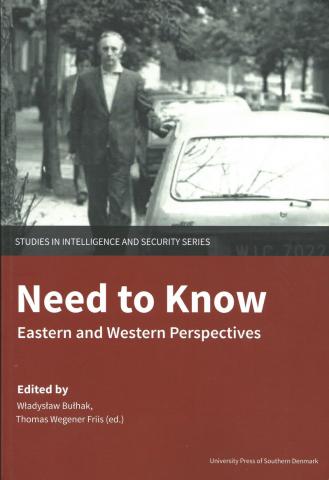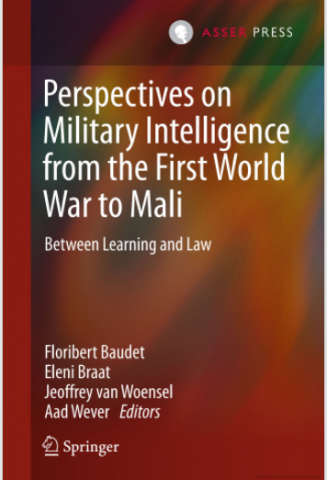Need to Know: Eastern and Western Perspectives door Ben de Jong

Władysław Bułhak, Thomas Wegener Friis (eds.), Need to Know: Eastern and Western Perspectives. N.p.: University Press of Southern Denmark (2014). 283pp. ISBN 978 87 7674 853 1, 300 DKK. Intelligence historiography was until recently almost completely dominated by the study of the history of intelligence and security services in Anglo-Saxon countries, particularly those of the US and Great Britain. Gradually this is changing. The archives of the East German Ministry of State Security and its intelligence service were the first in the former communist dictatorships of Eastern Europe to be made accessible to historians. This has resulted in a large number of publications about this service, most of them in German. Archives in other former communist states have gradually opened up as well. It is ironic, of course, that archives of intelligence and security services in the former communist countries of Eastern Europe are in most cases now much more accessible for historians than is the case with similar archives in the established democracies of Western Europe.
You get a sense of the interesting materials to be found in several of these archives by reading Need to Know: Eastern and Western Perspectives. The book is the outcome of a series of annual conferences organised by the Institute for National Remembrance in Warsaw and the University of Southern Denmark in Odense. Attention is given to services and operations during the Cold War, especially those from former communist Eastern Europe, which are not often discussed in English language publications on intelligence history.
Helmut Müller-Enbergs, who is a renowned authority on the history of the East German Ministry of State Security, in his contribution ‘How successful was the Stasi in the West after all?’ at first seems to try to answer the question which intelligence service in East or West was the best during the Cold War. He quickly concludes that an answer to this question is not possible, but he offers an impressive overview of the often spectacular successes the intelligence department of the Ministry of State Security, the Hauptverwaltung Aufklärung (HVA), had in the West, mainly in terms of the large numbers of agents it managed to recruit in often very sensitive places
Another chapter authored by Douglas Selvage discusses ‘Synonym’, an intelligence operation set up by Soviet Bloc services under the leadership of the KGB which aimed to influence the so-called Helsinki Process. This was the follow-up of the well-known Helsinki Conference for Security and Cooperation in Europe (CSCE) which had taken place in the Finnish capital in 1975. Synonym tried to influence public and official opinion in Western and non-aligned countries, especially around the time of the follow-up OSCE conferences in Belgrade (1977-78) and Madrid (1980-83), partly by spreading disinformation. It is wellknown that the KGB and other communist services during the Cold War attached great value to such operations.1 The tenor of operation Synonym was primarily to defend the Soviet Bloc countries against Western accusations of human rights violations and, alternatively, unmask alleged violations of human rights in the West. For his contribution the author made use especially of State Security Archives in Prague. As part of Synonym, reports were placed in the media in which Western criticism of the human rights situation in the Soviet Bloc was portrayed as interference in the internal affairs of those states. Western governments and NGO’s which criticised the Soviet bloc were accused of being opponents of détente and individual critics were often portrayed as agents of Western intelligence services. The Czechoslovak service preferred to get such reports published in prominent Western media, but it often chose, in a kind of fall-back position, to feed such reports to the media of their own country which were of course hardly in a position to say no to such a request. In one particular case a report critical of Western actions was placed in the communist party newspaper in Luxemburg, which can hardly be considered an indication of great success of the operation. For obvious reasons, as the author indicates, placing such material in the communist media in Eastern Europe or elsewhere was a poor second choice. Part of Synonym also consisted of ‘influence operations’ aimed at Western and non-aligned diplomats at the Belgrade and Madrid conferences. As one should in the case of disinformation and influence operations of communist intelligence services generally, the author questions the effectiveness of Synonym. In most cases where disinformation was placed in the media with an aim to discredit the West, its practical effect could hardly be measured. Given the proliferation of NGO’s of all kinds in the West, especially in the field of Human Rights, it simply proved too difficult for communist intelligence services to establish a credible organization for themselves as a front to counter the Western narrative.
Not all contributions deal with former communist Eastern Europe. There is a chapter, for instance, on the recruitment of Austrian citizens by foreign intelligence services, i.e. the services of the occupying powers, during 1945-53. The chapter is to some extent based on material from Russian archives. It turns out that after a short post-WW II period in which these services primarily focused on former Nazi collaborators and stay-behind networks, they mostly recruited Austrian citizens as agents to gather intelligence on other occupation zones and their occupation armies. The US Army Counter Intelligence Corps (CIC), for instance, became more and more interested in the goings-on in the Soviet zone of occupation in Austria. According to the author, the Austrian historian Dieter Bacher, these networks run by the British, American or Soviet services were mostly set up in a very amateurish way and basic rules of security were not heeded. The agents often supplied information verbally to their masters and rarely any documents. Networks were generally fairly short-lived and in the case of arrests by the Soviet authorities of American or British agents, the victims were often sent to Siberia or executed.
Kurt Jensen and Don Munton in their contribution ‘Early Years of the Canada-United States Foreign Intelligence Relationship’ make some interesting observations. Surprisingly, in Canada a foreign intelligence service was never established to carry out Humint operations abroad, along the lines of the American CIA or the British service MI6. Foreign intelligence collection was done by the Department of External Affairs and it was this department that was in charge of intelligence liaison with Western allies, in particular the United States.2
Certainly not everything is known about the collection of intelligence by External Affairs or what was shared with Canada’s allies. Jensen and Munton discuss three cases, however, about which it is known that External Affairs over a period of several years collected important intelligence which was shared with the Americans. These are Indochina in the 1950s and 1960s, Cuba in the 1960s and 1970s and Teheran in 1979-80. In the last case, as is wellknown, Canadian diplomats played an important role in facilitating the exfiltration of six American diplomats who had managed to avoid being taken hostage at the US Embassy in Teheran when it was being occupied by Iranian Revolutionary Guards in 1979. In all these three cases Canadian diplomats collected information which was shared with the US Government. They carried out their operations mostly in secret and made occasional use of secure communication devices supplied by the CIA, but it is not clear from this contribution if they also recruited and ran agents. In other words the authors do not make clear if these diplomats also filled dead drops, held meetings in safe houses, or similar activities.
An important contribution in this volume is ’Polish Intelligence in Brussels: The Agent, His Object, and the Subjective Historian’ by the Belgian historian Idesbald Goddeeris. In the archives of the former Polish intelligence service in Warsaw he looked up the file of Eryk (a pseudonym given to him by Goddeeris), who emigrated from Poland to Belgium after the end of the Second World War. Eryk became actively involved in circles of Polish émigrés and was known to Goddeeris personally as a friend. It becomes clear from the file that the Polish foreign intelligence service SB was very interested in Eryk: they tried to recruit him several times over the years, collected information about alleged extramarital affairs of his wife and they recruited his brother who had stayed behind in Poland. Goddeeris takes the decision to discuss the content of the file with Eryk, after which it becomes clear that the SB has several important details about the life and activities of the subject and his wife completely wrong. Important data like the year they got married and other basic facts in their biographies were not correct. The stories about his wife’s affairs which allegedly occurred in the 1950s are apparently not true either. In another sign of sloppy operational work on the part of the SB, it seems plausible that Polish intelligence officers operating in Belgium for the benefit of their own careers exaggerated the nature and frequency of their meetings with Eryk. In other words, Goddeeris comes up with a clear example which shows that the files of an intelligence service have to be handled with the same care a historian should apply to other sources for obvious reasons: they sometimes contain sloppy work, exaggerate achievements of officers in the field and have basic facts plain wrong.
This volume is an interesting addition to intelligence literature from a somewhat unexpected corner, even though, on a slightly critical note, a closer look at the English of some of the contributions would not have been a bad idea.


